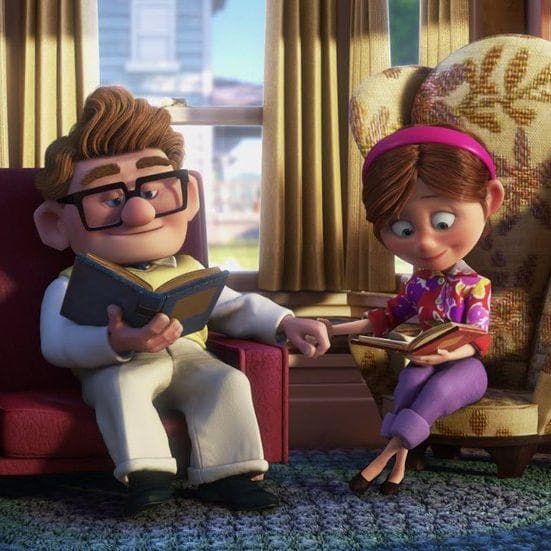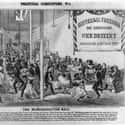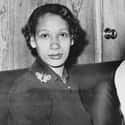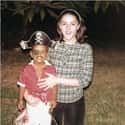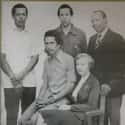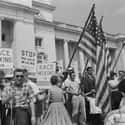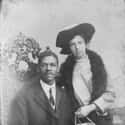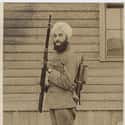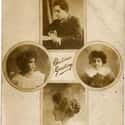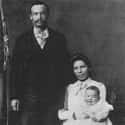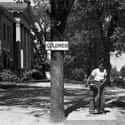-
(#1) One Couple Was Sent To Prison Just For Living Together – And The Supreme Court Said It Was Legal
In the wake of the Civil War, Missouri representative Andrew King proposed a constitutional amendment in 1871 that would ban marriage between whites and people of color. It failed at the time. But 10 years later, a Black man named Tony Pace and a white woman named Mary J. Cox were arrested in Alabama simply because they were living together. The law there was so broadly written that the couple didn't even have to be married to violate the law, and they were both sentenced to two years in prison for the crime.
The couple appealed the conviction all the way to the Supreme Court, but in Pace v. Alabama, the court ruled that the law was not discriminatory because both received the same prison sentence regardless of race. The ruling would hold for more than 80 years.
-
(#2) Lucille Ball And Desi Arnaz Caused Network Turmoil Because Of Their Interracial Marriage
I Love Lucy is one of the most iconic TV shows in history — and it almost didn't get on the air because of bigotry. Lucy's biographer, Kathleen Brady, says the network did not want Lucy's husband Desi Ricardo on the show at all. Both "CBS and its sponsor, Philip Morris cigarettes, were adamantly opposed to this. They said that the American public would not accept Desi as the husband of a red-blooded American girl." But Lucille Ball put down her foot, and the rest is history: Lucy and Desi became household names.
CBS was so worried that they insisted on twin beds in the Ricardo bedroom, and even outlawed the word "pregnancy," (as too vulgar) in the episode where Lucy finds out she's expecting. But the show's premier in 1951 as the first television program to feature an interracial couple was a smash hit — perhaps because racists decided the marriage was acceptable because of Arnaz's European heritage.
-
(#3) Sammy Davis, Jr. And His Swedish Wife Challenged Social Conventions
When entertainer Sammy Davis, Jr. married Swedish actress May Britt in 1960, their marriage was illegal in 31 states. In fact, John F. Kennedy even asked the couple not to appear at his inauguration because he feared a backlash from white Southerners.
The pair did face a backlash: Britt was dropped by 20th Century Fox because of the interracial relationship, and their daughter, Tracey, says Sammy Davis, Jr. worried about the future for biracial children. "What will the world be like for Tracey? What will our legacy be for our children? Is it going to be any better."
The couple tried to make the world a better place: in the 1960s, they were active in the Civil Rights Movement, and Sammy participated in the 1963 March on Washington. He also refused to perform at racially segregated nightclubs––a move which helped integrate nightclubs in Las Vegas and Miami Beach.
-
(#4) Mildred And Richard Loving Were Banned From Virginia Until They Fought All The Way To The Supreme Court
Their name became famous because of Loving v. Virginia, but Mildred and Richard Loving started out as a couple in love. Mildred Jeter met Richard Loving in the 1950s, when both lived in Virginia. Interracial marriage was illegal in their state, so they crossed the border to Washington, D.C. when they got married in June of 1958. But a few weeks later, Virginia charged the couple with breaking the law and sentenced them to one year in jail — or a 25-year ban from the state.
The terrified couple moved to DC, but they were arrested again five years later for visiting Mildred's parents. They wrote to Attorney General Robert Kennedy for help, and a few years later their case was in front of the Supreme Court. On June 12, 1967, the court overturned all bans on interracial marriage, declaring, "Marriage is one of the 'basic civil rights of man,' fundamental to our very existence and survival."
-
(#5) Thousands Of Families Were Affected By The 'Loving' Decision — Including Barack Obama's
The Supreme Court decision in Loving v. Virginia didn't just affect Mildred and Richard Loving — it affected thousands of ordinary families who simply wanted to exist. And although no one knew it in 1967, one of those families belonged to a future president.
When Ann Dunham married Barack Obama, Sr. in 1961, their union was only legal because they married in Hawaii — one of only nine states that never declared interracial marriage illegal. The two met while taking a Russian language class at the University of Hawaii. Ann was only 18 years old.
Barack Obama was still a boy when Loving v. Virginia ruled against interracial marriage bans, a decision that made it possible for interracial families to live across the river from Obama's future home––the White House.
-
(#6) The President Of Botswana Married A White Woman, And Britain Practically Imprisoned Him
Prince Seretse Khama left Botswana to earn a law degree in London where he met his future wife, Ruth Williams. It took Seretse three months to get enough courage to ask Ruth on a date. He invited her to a jazz concert and offered to invite her sister if it would make Ruth more comfortable. She replied, “I’d love to come — without my sister.” When the two married in 1948, Ruth's family disowned her and she was fired from her job, while Seretse was banned from returning to Botswana.
In order to appease apartheid South Africa, the British government refused to let Seretse leave the country, arguing that it would "endanger peace." But in 1956, Seretse and Ruth were allowed to travel to Botswana where Seretse was eventually elected the first president of the democratic country.
-
(#7) Fears Of Interracial Relationships Led One Man To Turn On His Wife
In 1924, the son of a wealthy New York family married a blue-collar woman whom headlines declared was "the Daughter of a Colored Man." According to the "one-drop rule," even a single drop of African blood made someone Black. So Alice Jones, who had at least one Black grandparent, qualified by the standards of the 1920s. Her marriage to Kip Rhinelander was short and tragic, all thanks to the huge scandal that pressured Kip to divorce Alice. Unfortunately, it worked.
The three-year courtship and marriage ended when Kip sued Alice for "hiding" her ancestry and tricking him into thinking she was white. Kip's shame at being publicly linked to a Black woman drove the trial, as when his lawyer declared Kip would not tolerate "the undying disgrace of an alliance with colored blood."
Alice was forced to show her nude body to the jury to prove that she had never lied about her race. The jury found in Alice's favor and she received alimony for Kip for 65 years.
-
(#8) Louis and Louisa Gregory Fought For Civil Rights But Couldn't Travel Together
Louis Gregory was a prominent lawyer. Louisa Mathew was an educated woman born in England. But when the two married in 1912, they set off a fire storm. Their marriage was illegal in more than half of the states and considered unacceptable across the country. To prevent an outcry, few were invited to the wedding. Louis explained, “We do not wish any sensational newspaper articles written.”
Their marriage was not easy. The two struggled to find a place to live, during the era when Jim Crow laws tried to completely separate Blacks and whites. The Gregorys were warned not to travel together by friends, and when Louis traveled to the South to fight for civil rights, Louise had to stay in New York. The pair didn't live to see Loving v. Virginia––after four decades of marriage, Louis passed away in 1951 and Louisa died in 1956.
-
(#9) In The 1920s, The US Government Decided Asians Were Not White And Punished White People Who Married Asians
Most laws against interracial relationships applied only to relationships between whites and Blacks — until the US Supreme Court ruled in 1923 that Asians were not white. In spite of being the original "Caucasians," in the case of US v. Bhagat Singh Thind the Supreme Court decided that Asian Indians could not become citizens because only "free whites" could become naturalized citizens. Thind, a veteran on World War I who fought for the US, went on to earn a PhD in spite of the court's ruling that he was ineligible for citizenship.
Just one year earlier, in 1922, the Cable Act stripped the citizenship of any US citizen who married "an alien ineligible for citizenship," which targeted Asian American immigrants. The government then revoked the citizenship of Mary Keatinge Das, the wife of a Pakistani-American activist who was herself a natural-born citizen. Emily Chinn, another citizen who married a Chinese American immigrant, also lost her citizenship.
-
(#10) An Interracial British Couple Faced Discrimination And Tragedy So That Their Children Could Become Distinguished Musicians
In 1899, a British composer named Samuel Coleridge-Taylor married Jessie Walmisley. They wed in a parish church in the English countryside, with Samuel's mentor and Jessie's father present to sign the marriage registration. But this wasn't a typical English wedding: Samuel's father immigrated to London from Sierra Leone, and the Walmisleys were an established English family who vehemently opposed the marriage.
Samuel and Jessie were probably the only interracial couple that most in the English town of Croydon had ever seen. As they walked the streets, gangs would harass the couple. Their daughter later reported, "When he saw them approaching along the street he held my hand more tightly, gripping it until it almost hurt." Samuel and Jessie persisted, with his composing career taking off, until he tragically died from pneumonia at the young age of 37. Their two children went on to have distinguished careers as composers and conductors.
-
(#11) The Laws Specifically Targeted Whites Marrying Non-Whites
So-called "miscegenation" laws stated that whites could not marry non-whites, in a philosophy going back to Maryland's colonial law from 1664 which warned against "diverse freeborn English women forgetful of their free condition and to the disgrace of our Nation do intermarry with Negro slaves." White women who married Black men were ordered to become slaves as long as their husband lived.
The laws were based on the racist assumption that "race mixing" would harm the white race, but they rarely mentioned interracial marriages that did not involve whites. For example, George Douglas, who was white, Hawaiian, and Indian, married Nettie Sparrow, who was white and Indian, but in spite of their backgrounds, neither was considered white so the marriage did not violate anti-miscegenation laws.
-
(#12) An Anonymous Interracial Couple Fought Segregation To End Laws Against Interracial Sex
In addition to laws banning interracial marriage, many states also made it a crime for people of different races to have intercourse or even cohabitate. In 1964, a brave couple from Florida challenged the law, taking the case all the way to the Supreme Court. In McLaughlin v. Florida, the anonymous couple argued that a state law banning whites and Blacks from living together was unconstitutional.
The unanimous ruling at the Supreme Court declared that laws banning interracial cohabitation or "fornication" were illegal, directly countering the 1883 case of Pace v. Alabama. But it would take three more years before the Supreme Court ruled on interracial marriage.
New Random Displays Display All By Ranking
About This Tool
In the past, interracial marriage has always been taboo for the Jewish nation, and it was illegal in almost every American state during certain periods. But in the second half of the 20th century, due to the openness of American society, American Jews have become more and more assimilated and integrated into American society, and the intermarriage between Jews and non-Jews has changed. It becomes quite common.
In 1967, the US Supreme Court's ruling in the Loving v Virginia case opened up legal intermarriage between different races (black and white). The random tool shares 12 details about how these trailblazing relationships changed the taboo of interracial marriage.
Our data comes from Ranker, If you want to participate in the ranking of items displayed on this page, please click here.






